Charles Rosson .22 Martini Match Rifle
Charles Rosson snr. (bn. 184?) was initially listed as a Birmingham gunmaker, subsequently starting a gunsmithing business in Derby, building it up to a point where it had a national reputation, mainly for good quality shotguns, and eventually marketing his firearms abroad. He had two sons, the younger also being named Charles (C.S.), who he set up in premises in Norwich. It seems that Charles' elder brother was also in the trade, which may account for the family name also being linked with Warwick, but that the two brothers failed to get on, and each would barely recognise the existence of the other.
The particular rifle represented on this page was retailed from Norwich,
and therefore probably a product of Charles Jnr.'s side of the firm.
The left-hand-side plate of the receiver body is simply engraved
"CHARLES ROSSON"
"NORWICH"
For the rotational images on these pages,
drag horizontally to rotate subject.
Click to zoom and drag to pan.
Full screen viewing from expansion arrows.
The barrel is hand-engraved between the reinforce and the tangent sight
" CHARLES ROSSON, 13 RAMPANT HORSE STREET, NORWICH & DERBY "

The knoxform and reinforce carry the engravings
" THE MATCH RIFLE "
and
" .22 LONG RIFLE CARTRIDGE "
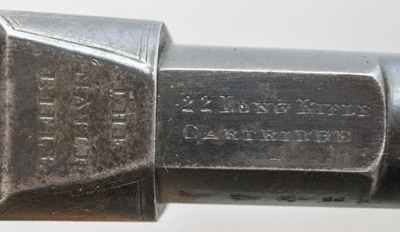
The proof marks would suggest that the rifle dates between 1904 and 1925,
and, if so, probably during the latter half of that period.
The mark at the left of the lower line is the
Birmingham Proof House provisional proof mark that allows a manufacturer to have
their barrel checked as being satisfactory before further finishing work is undertaken.
The others are for the final inspection and definitive proof.

The rifle is here shown disassembled
The image can be zoomed and panned
Early in the Twentieth Century, most British small-bore, or 'miniature calibre' Martini-actioned rifles were built up on the large frame of the service issue Martini-Henry rifle or its following Metford and Enfield barrelled models.
Regular use of small-framed rifles arrived in Britain largely with the advent of the Birmingham Small Arms Company's products, such as the famous Martini Cadet rifles and their civilian target rifle, the BSA Model 12, although William Greener not unreasonably laid claim, in his book "The Gun and its Development", to being at the forefront of their introduction to British small-bore shooting in 1901 with his "Sharpshooter's Club" rifle of .310" calibre.
Such rifles had already been available in Europe, and the well-known Francotte models were often imported to Great Britain. The small actions of such French and Belgian rifles were brought into the country and built into rifles sold on the home market by British gunsmiths. The origin of the actions of such rifles are not easily identifiable.
A particular distiction of most of the small-framed actions over their full-bore Martini-Henry type predecessors is that the small-bore models' actions were in one piece, with the falling block being pinned into the action frame with the trigger, sear, tumbler and ejector unit being extracted from under the receiver by removal of a locking pin passing through the body and action.
The large-frame service rifles had the falling block pinned separately through the top rear of the receiver's side plates,
and the internal trigger parts, tumbler and ejector were separate from the block.
Our example Rosson rifle is built along the lines of the service rifle's action,
as can be seen in the 'exploded' image of the rifle's components above.
This is a less common arrangement in small-frame Martini rifles,
although some of the early 20th. Century rifles by W.W. Greenerwere so constructe.
The barrel has the usual 6-groove rifling with square-edged lands common with many .22 rifles through the years,
particularly converted Martini-Henry/Enfield rifles such as those of W.W. Greener or his contemporary C.G. Bonehill.
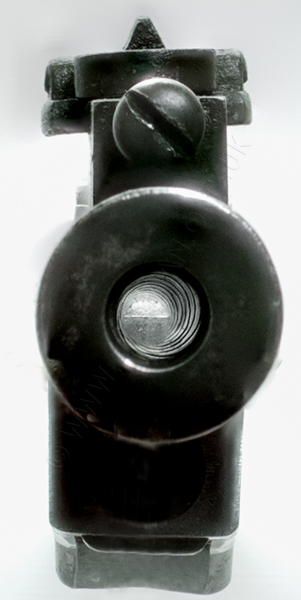
The fold-over fore-sight affords a ringed aperture when raised, or a plain blade when dropped.
The locking screw at the front of the mount permits easy windage adjustment.
The barrel has not been sleeved (or Parkerifled)
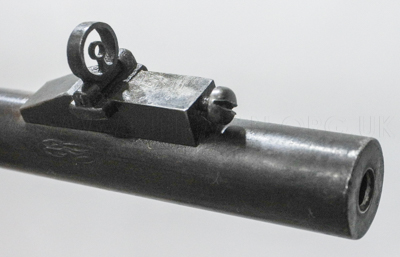
The serial number of the rifle, 2426, is stamped out of sight under the barrel beneath the fore-end woodwork.
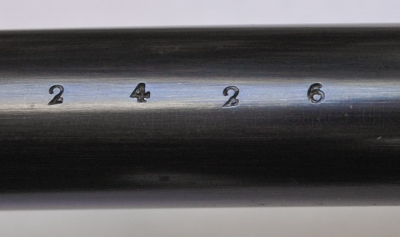
and finely engraved beneath the trigger guard for external reference.

Unusually, the rifle has had weight added, with lead poured into both a groove in the fore-end,

and into three holes bored in the butt-stock.
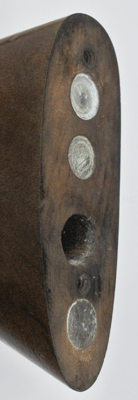
As the rifle was marketed as "The Match Rifle", this presumably had more to do with stability than balance;
the latter perhaps would have been the case with a sporting rifle.
The barrel tangent sight is a full-bore model without any small-bore calibration,
such as the 25/5/10 yards marks often added to the side of the mount base on such rifles,
but it is fitted with a fine windage adjustable slide,
with the usual "U" notches for both the low and raised leaf positions.
The underside of the leaf is stamped with a four digit serial number 2520
that is higher than that of the rifle of 2426,
and may, or may not, have any connection with Rosson serialling.
It has been reported that the Rossons used the first two digits of their serial numbers
as a prefix to denote the year of manufacture, indicating that this rifle may date from 1926,
and that the sight leaf may even have been removed from a rifle they produced in 1925.
The latter pair of digits relate to the nth. rifle produced in that year.
The company's records were destroyed during a bombing raid in 1942,
and the serialling system changed after the War,
eventually becoming the more commonly used continuing numbering series.
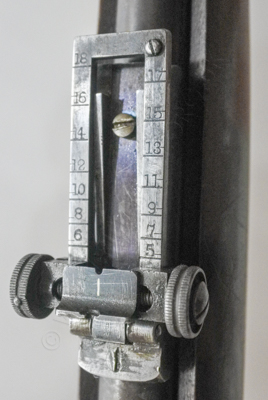 ...............................
............................... 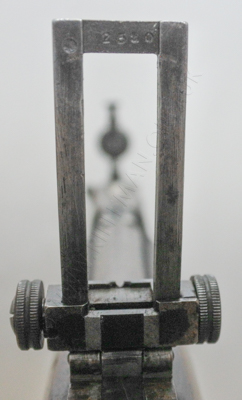
Below, the BSA Model No.8 folding rear aperture sight.
That of the Rosson rifle is on the left, and is an early model carrying the 1907 patent no.26943,
and the Registered Design number 53320.
By the 1930s, the sight's design had been modified to that of the example on the right,
photographed on a Bonehill converted large-frame Martini-Henry/Enfield service rifle
made for the Society of Miniature Rifle Clubs.
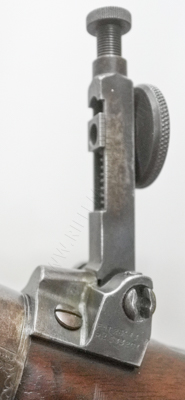 ..................................
.................................. 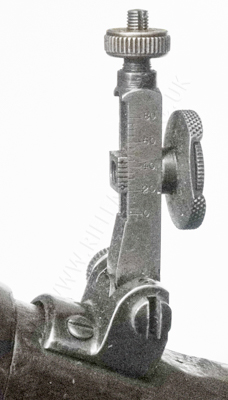
Return to: TOP of PAGE
See this website's Raison d'être

